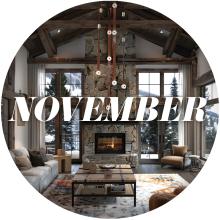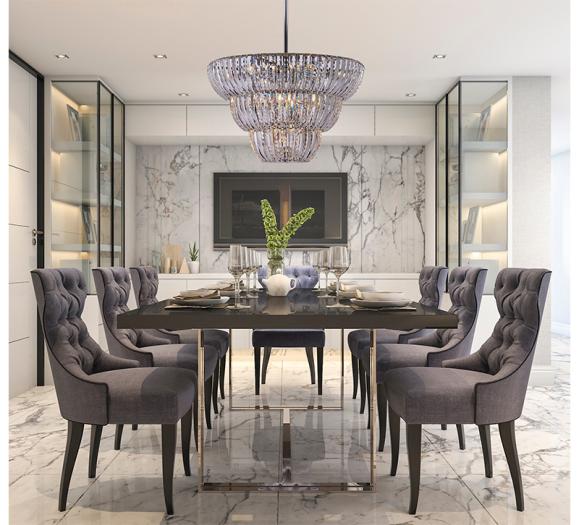The home has become a place where we do it all: live, work, learn, dine and entertain ourselves. Homes are getting refreshed as their inhabitants start to uncover their shortcomings, from both style and functionality standpoints. Those outdated lighting fixtures that once were tolerated and ignored are now becoming a glaring issue. As the design styles of today’s homes take a turn for the comfortable, trends in lighting seem to be following suit.
Styles & Finishes
Greg Martin, Creative Director for Kichler Lighting, is seeing a mixed bag when it comes to trending style. Glam Art Deco, global boho looks and an updated traditional farmhouse style are all emerging trends.
“To me, Art Deco in some ways is kind of a natural progression from Mid-Century Modern, but going the opposite direction, getting a little bit more refined with it, a little less fun,” Martin says. “It’s a little more serious, a little more updated traditional in its influences. I think part of that comes from a desire to get a little bit more refined in looks after the super rustic trend or Mid-Century being a little bit more lighter and fun.”
Colleen Visage, Vice President of Product Management for Progress Lighting, also noted a shift toward updated traditional.
“We’ve identified a shift back to a ‘new’ traditional look that fuses a familiar, classic look with modern and cleaner lines that are less embellished,” she says.

With this melding of styles also comes the mixing of materials. Clear glass sharing a fixture with dark iron, mixed surface treatments on metals and a combination of textures on one piece help blur the lines between design styles.
In finishes, black and gold remain a hot pairing, according to both Martin and Visage, and, as is the case elsewhere in the home, cold neutrals are warming up, contributing to a softer, comfortable feeling.
“It’s amazing how people just can’t seem to get enough black fixtures right now,” Martin says. “And any kind of neutral tone or earth tones. The greys are getting warmer, like a greige, and there are more warm-neutral lighter wood tones. I think that’s coming from the Scandinavian or Scandanese influence where the wood tones are getting lighter and more natural.”
Natural materials continue to trend, identifying a desire to connect with the outside. At this fall’s High Point Market, new introductions were rife with rope-covered lighting elements, rattan shades and cerused wood finishes, all catering to this desire for a soft, comfortable atmosphere that brings a bit of the natural world indoors.
“I think we’re going to see more of that with the COVID impact,” Martin says. “There’s kind of this back to the home, back to natural materials trend, with people doing a lot of handicrafts or doing things they may have never have done before, trying things like gardening. I think you’re going to see this return to wanting things that have a little bit more nature to them and less machine-made looks.”
While trends can sometimes look dated, freezing a home in a particular place in time, today’s melding of design styles and materials means lighting fixtures have a certain element of longevity.
“I’d encourage designers to seek out fixtures that feel familiar and feature classic undertones with refreshing elements and finishes,” Visage says. “Many fixtures today have clear glass or exposed lamps that can modify the ‘light bulb’ style, which refreshes the look.”
Kichler approaches trends by hinting at them, rather than coming at them full force. Martin suggests designers do the same to get the most life from a fixture — especially given the financial investment often
associated with lighting.
“Focus on finishes and materials that will have more life to them,” he says. “Maybe the trend is going away, but the finishes in the piece are there, the materials still will tie into your decor and you can still accessorize and keep that fixture by maybe shifting out some other decor pieces.”
Making It Work
Beyond style, functionality is also driving lighting choices. But this function has to work in tandem with the style.
“If quarantine taught us anything it’s the need for a space to be multi-functional, yet still retain its original intended essence,” Visage says.
For Progress, much of this functionality lies in the controls. The company is gearing up to launch WiFi controllability in ceiling fans, Visage says, and the ability to change LED color temperature in a fixture from warm to neutral to cool can help change the atmosphere as a room’s function shifts throughout the day.
LED is an important piece of technology at Kichler, as well. Integrated lighting elements help product designers create more sculptural pieces that can stand alone as art when unlit.

The style and functionality of today’s lighting fixtures are intertwined now more than ever before. Our homes are the center of our lives, and the outdated fixtures that we once put off replacing are now front and center. To that end, Martin sees homeowners opting to update their lighting in the rooms in which they spend the most time: living rooms and kitchens, as opposed to bathrooms, he says.
“The home has always been your place to go relax,” Martin says. “I believe now people are wanting to update their lighting so it can be a functional office during the day, and at night be a nice place to have a really relaxed dinner. They’re spending so much more time at home and want to make it a place that’s their sanctuary.”
Part of creating this sanctuary is the ability to express your personal style. Lighting function is an important factor that contributes to the overall comfort of a space, but that comfort is only worth so much if the fixture isn’t aesthetically pleasing.
“I think people are focusing on style more and lighting has been one of those things that certainly in the last 10 to 15 years has seen a huge shift from being purely a functional piece that’s meant to disappear to being something that’s like a statement piece and says something about you and your style and your tastes,” Martin says. “I only see that continuing.”







